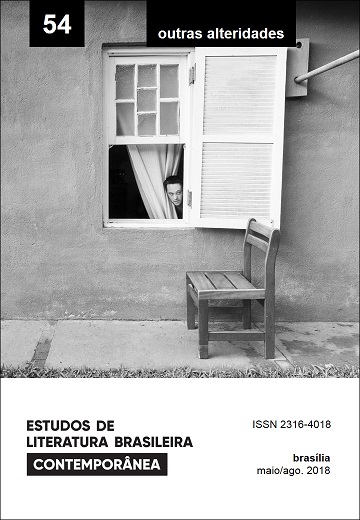Literatura infantil e a alteridade polidáctila deixada para a próxima página
DOI:
https://doi.org/10.1590/10.1590/2316-4018542Resumo
Rorbeto é um garoto polidáctilo que nos acena e assinala a presença do corpo diferente na obra literária infantil. Ainda que, na contemporaneidade, discurso e imagem, diálogos e figuras encontrem-se na literatura infantil, parte-se do pressuposto de que a alusão ao corpo diferente na obra literária infantil tem sido ainda tímida, haja vista que, quando esse corpo aparece na obra, é comum contribuir para a manutenção de estereótipos e estigmas, oriundos de processos culturais em que o estranhamento à diferença corporal tenha oportunizado o entendimento desta diferença como fator de exclusão. Por sua vez, na obra literária Um garoto chamado Rorbeto (2005), escrita por Gabriel O Pensador, e ilustrada por Daniel Bueno, percebe-se a presença de um corpo diferente, em maior amplitude, distinto do que se via em outras épocas, porém, um corpo reivindicante, ainda, de aparições mais regulares, não deslocadas, desmistificadas.
Referências
ABCMED (2014). Polidactilia: definição, tipos, causas, sinais e sintomas, diagnóstico e tratamento. AbcMed, [S.l.], 5 fev. On-line. Disponível em: <https://goo.gl/8BXpGG>. Acesso em: 27 abr. 2016.
BARROS, Alessandra Santana Soares e (2015). Quarenta anos retratando a deficiência: enquadres e enfoques da literatura infantojuvenil brasileira. Revista Brasileira de Educação, Rio de Janeiro, v. 20 n. 60 p. 167-193, jan./mar. Disponível em: <https://goo.gl/7ZzrNZ>. Acesso em: 27 maio 2017.
BONIN, Iara Tatiana; SILVEIRA, Rosa Maria Hessel (2010). As formas do corpo: marcas da(s) diferença(s) em personagens gordos da literatura infantil. Currículo sem Fronteiras, [S.l.], v. 10, n. 2, p.77-90, jul./dez. Disponível em: <https://goo.gl/nDCKfb>. Acesso em: 27 maio 2017.
CADEMARTORI, Ligia (2009). O professor e a literatura: para pequenos, médios e grandes. Belo Horizonte: Autêntica.
CANDIDO, Antônio. A literatura e a formação do homem. In: CANDIDO, Antônio. Remate de Males, Campinas, v. 19, n. 3, 1999, p. 81-90. Disponível em: <https://goo.gl/ovgvg6>. Acesso em: 9 mar. 2016.
EAGLETON, Terry (2006). Teoria da literatura: uma introdução. Tradução de Waltensir Dutra, revisão da tradução de João Azenha Jr. 6. Ed. São Paulo: Martins Fontes.
FREIRE, Paulo. A importância do ato de ler (1998). In: FREIRE, Paulo. A importância do ato de ler em três artigos que se completam. São Paulo: Cortez. p. 11-21.
FIORIN, José Luiz (2014). Elementos de análise do discurso. 15. Ed. São Paulo: Contexto.
FOUCAULT, Michel (2010). Os anormais: curso no Collège de France (1974-1975). Tradução de Eduardo Brandão. São Paulo: Martins Fontes.
LAJOLO, Marisa (2002). Do mundo da leitura para a leitura do mundo. 6. Ed. São Paulo: Ática.
LE BRETON, David (2013a). Antropologia do corpo e modernidade. 3. Ed. Tradução de Fábio dos Santos Creder Lopes. Petropólis: Vozes.
LE BRETON, David (2013b). Adeus ao corpo: antropologia e sociedade. 6. Ed. Tradução de Marina Appenzeller. Campinas: Papirus.
MANGUEL, Alberto (2008). A cidade das palavras. Tradução de Samuel Titan Jr. São Paulo: Companhia das Letras.
MUNIZ, Dinéa Maria Sobral; MORAES, Giselly Lima de (2007). A literatura na escola como presença de outros. In: MUNIZ, Dinéa Maria Sobral; SOUZA, Emília Helena Monteiro de; BELTRÃO, Lícia Maria Freire. Entre textos, língua e ensino. Salvador, Edufba. p. 165-178.
ORLANDI, Eni P (2015). Análise do discurso: princípios e procedimentos. 12. Ed. Campinas: Pontes.
PAIVA, Aparecida; RODRIGUES, Paula C. de Almeida. Letramento literário na sala de aula: desafios e possibilidades. In: MACIEL, Francisca Izabel Pereira; CASTANHEIRA, Maria Lucia; MARTINS, Raquel Marcia Fontes. (Org.). Alfabetização e letramento na sala de aula. 2. Ed. Belo Horizonte: Autêntica, 2009.
GABRIEL O PENSADOR. Um garoto chamado RoÑbeto. São Paulo: Cosacnaify, 2007.
SIMÕES, Darcília (2006). Considerações sobre a fala e a escrita: fonologia em nova chave. São Paulo: Parábola.
Publicado
Edição
Seção
Licença
Autores que publicam nesta revista concordam com os seguintes termos:
a) Os(as) autores(as) mantêm os direitos autorais e concedem à revista o direito de primeira publicação, sendo o trabalho simultaneamente licenciado sob a Licença Creative Commons de Atribuição-Não Comercial 4.0, o que permite o compartilhamento do trabalho com reconhecimento da autoria do trabalho e publicação inicial nesta revista.
b) Os(as) autores(as) têm autorização para assumir contratos adicionais separadamente, para distribuição não-exclusiva da versão do trabalho publicada nesta revista (ex.: publicar em repositório institucional ou como capítulo de livro), com reconhecimento de autoria e publicação inicial nesta revista.
c) Autores têm permissão e são estimulados a publicar e distribuir seu trabalho on-line (ex.: em repositórios institucionais ou na sua página pessoal) após o processo editorial, já que isso pode gerar alterações produtivas, bem como aumentar o impacto e a citação do trabalho publicado (Veja O Efeito do Acesso Livre).
d) Os(as) autores(as) dos trabalhos aprovados autorizam a revista a, após a publicação, ceder seu conteúdo para reprodução em indexadores de conteúdo, bibliotecas virtuais e similares.
e) Os(as) autores(as) assumem que os textos submetidos à publicação são de sua criação original, responsabilizando-se inteiramente por seu conteúdo em caso de eventual impugnação por parte de terceiros.


